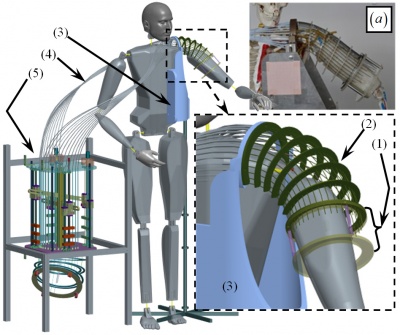From Rii
A Continuum Exoskeleton for Upper Extremity
September 2010 to present
![]() This work was supported by Program for New Century Excellent Talents in University (the NCET Program).
This work was supported by Program for New Century Excellent Talents in University (the NCET Program).
Exoskeleton research attracted a lot of attentions in the past decades. Numerous exoskeleton systems were developed for upper and lower limbs for military and medical purposes. These exoskeleton systems either aim at augmenting a healthy wearer’s physical capabilities with robotic actuation or to allow rehabilitation for neuromuscular defects after stroke or injury.
Despite their different applications in military or medicine, many existing exoskeleton systems yet followed one similar design approach: using different control and sensing schemes, rigid kinematic chains are actuated to mobilize an attached human wearer. The use of rigid links in an exoskeleton might be justified in applications for strength augmentation to undertake excessive external loads and shield the wearer. But the use of rigid links introduced drawbacks such as bulkiness, high inertia, and most importantly the difficulty of maintaining kinematic compatibility between exoskeleton and human anatomy. In a clinical setting for rehabilitation where one exoskeleton consisting of rigid links is shared by multiple patients, it is even more difficult to guarantee the on-site adjustments performed by therapists can make the rigid exoskeleton fit each individual patient perfectly. Hence design approaches of using non-rigid components could be explored.
This project
